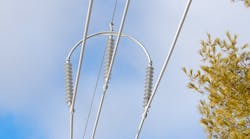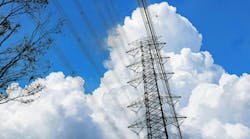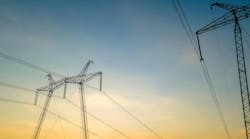Since the first electric power transmission line was built in 1889, essentially the same technology has been used for construction: bare wire (ACSR, AAAC, AAC, etc.), strung on porcelain insulators, supported by towers or robust poles. That paradigm abruptly changed in 1995 with the introduction of aerial covered conductor.
Like bare wire construction, aerial covered conductor uses standard aluminum and copper wires. The difference is that a 3-layer design of insulation covering is added. The coverings include a thin semicon layer (to smooth out electric fields when in contact with a grounded object and minimize partial discharge) directly over the bare wire, an inner layer of low-density polyethylene (which gives a high BIL and is soft to enable stripping for taps and transitions), and an outer layer of high density polyethylene (providing UV inhibition, track resistance, abrasion resistance, and color). The total thickness of the three layers depends on the voltage class, as the design objective is to limit the available surface current should the phase conductor come into contact with a tree or other grounded object.
There are two configurations for covered conductor systems. Spacer Cable Systems utilize three heavily covered conductors (usually AAC since there is no tension in the phases) supported by a high strength messenger wire and hung by polyethylene spacers every 30 feet. Tree Wire systems, on the other hand, look more like bare wire construction. It utilizes the same 3-layer covered conductor design, but the phase conductors are usually either ACSR or AAAC (since it is fully self-supported and tensioned). It is strung in an open wire configuration on crossarms with polyethylene insulators.
Traditional reasons for using covered conductor systems are improved reliability, reduced tree trimming, storm hardening, improved voltage regulation, multi-circuit construction, economics, and environmental stewardship (protecting the flora and fauna). Covered conductor technology broke into the transmission classes first in 1995 with the introduction of 69 kV spacer cable, and then in 2017, raising to the 115 kV class.
The many benefits of covered conductor are well proven at distribution class voltages and are similarly achieved at transmission voltages. However, the higher voltage classes bring additional challenges. The most pressing are how to expand bulk power delivery in existing ROWs, and how to acquire new ROWs. Not only are existing facilities aging and in need of replacement, but we need to plan how to transmit new generation from far flung renewable sources (wind turbines scattered along mountainous ridgelines and solar plants deep in the desert) back to population areas for consumption.
Renewable power is expected to grow 42% by 2050, but as much as 1,000 GW of clean energy projects remain uncertain due to the lack of transmission infrastructure. New transmission line permits are extremely difficult to obtain due to environmental, social, and political pressures. It can take decades before a permit is granted for a new ROW. Legacy transmission infrastructure is old and outdated, and neither the conductors nor the towers and poles can handle new, expanded requirements. Add to this the desire for new lines to be more robust, for both system hardening in the face of harsh weather and for wildfire mitigation. Covered conductors help in this regard as they don’t have enough surface current to cause ignition, and if they fall to the ground and hit a rock or something hard, the polyethylene jacket will prevent a spark from being thrown onto dry brush.
Attention is increasingly being given to the environmental consequences of building transmission lines. What is the impact? What is the difference between building a bare wire line and a spacer cable line? Calculations have shown that for every mile of a 100-foot ROW through a forested area, approximately 12 acres of trees are lost. In the Midwest region where the average number of trees in an acre is 200, a new 50-mile transmission line would result in the loss of approximately 120,000 trees. Spacer cable construction on this same route would save approximately 240 acres and 48,000 trees. Green spaces counteract a significant amount of carbon pollution (fossil fuel burning by cars, power plants, buildings, etc.), slowing the rate of CO₂ in the environment.
The demanding infrastructure change requirements coupled with the urgent timeline to replace aging infrastructure and the need for new additional transmission lines leads us to consideration of project life cycles for various options. Namely, expanding existing ROWs versus acquiring new ROWs. Looking at acquiring a new ROW, it can take up to a year for the Route Study and Site Survey, somewhere between five and ten years for Permitting (negotiations with landowners, easement acquisition and land clearing), another one to two years for design and procurement, and more for construction and commissioning. While fast-tracked projects can go online as soon as 7 seven years, projects more commonly take closer to thirteen years. However, utilizing an existing ROW for a new transmission line can cut this timeline drastically from 7-13 years down to 2-3 years.
Utilities currently face unprecedented challenges for upgrade and expansion of transmission facilities. Pressure exists to reduce costs, shorten the approval process, reduce outages, minimize visual impact, avoid forced outages, and help the utility achieve the environmental portion (flora, fauna, carbon footprint) of their strategic roadmap. As these utilities migrate from legacy systems to new, compact, aesthetically acceptable, environmentally friendly, storm hardened with wildfire mitigation attributes, we will see more transmission projects using covered conductor technology.
Sponsored by:



